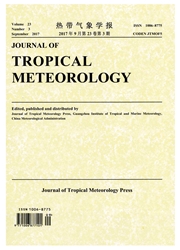

 中文摘要:
中文摘要:
采用具有2km分辨率的中尺度气象模式WRF及其耦合的单层城市冠层模式,以及Thompson云微物理方案,针对广州市附近发生的一次对流风暴过程,模拟研究了城市环境包括城市地表性质变化、城市空气污染可能引起的云粒子浓度增大现象对对流降水发展的影响问题。结果表明城市地表引起的热岛和干岛效应,可造成城市边界层高度升高,有利于城区附近辐合流场形成和不稳定能量增大。模拟结果显示,城市地表作用可在广州市南北各形成一个对流有效位能CAPE增大的辐合区,模拟对流降水回波起始发展于这些具有高不稳定能量的辐合区,并与观测雷达回波特征相一致,反映出城市地表对对流的起始发展及其发生位置有更直接作用。对流发展起来后,敏感试验反映出高云粒子浓度(污染)情形中有更多降水形成,降水增多可达20%以上。诊断分析发现降水增多与对流云中有更多雨水及过冷却云水形成有关系。增多的云水雨水通过相应的由于潜热释放增加引起的强上升运动被传送到较高层次,引起云中冻结过程及液态水和冰相物质之间的相互作用增强,从而导致更多冰相物质形成、降落地面降水增多。
 英文摘要:
英文摘要:
Using a 2-km-resolution WRF model, along with its single-layer urban canopy model and Thompson bulk-parameterization microphysics scheme, numerical simulation of a convective rainstorm is executed over Guangzhou city in the Pear River Delta (PIE)) to investigate the impacts of urban environments (including urban land use changes and urban air pollution-enhanced cloud droplet number concentration) on the convective precipitation. Results indicate that urban heat island and dry island effect produced by the land surface can lead to an enhanced urban boundary layer, which is conducive to air confluence and unstable energy increase in the areas near the city. Simulation shows that to the north and south of Guangzhou city, caused by the urban land surface, there exists respectively a convergence zone with enhanced CAPE (Convective Available Potential Energy) values. The simulated radar echoes being initiated within these zones and consistent well with observations reflect that the urban land surface plays a more direct role in convection initiation and development. Once convection develops, sensitive experiments show that enhanced cloud droplet number concentration might lead to more precipitation. In case with high concentration (polluted cases), precipitation is increased by up to 20%. Diagnostic analysis suggests that the increased precipitation results from that more rain water and supercooled cloud water produce in the convective clouds. These rain and cloud water, carried upward by strong upward motion intensified by more latent heat release during this process, can be transported to higher altitudes, where ice formation is enhanced through freezing or through interaction with other already existing ice species, and that finally results in surface precipitation increase.
 同期刊论文项目
同期刊论文项目
 同项目期刊论文
同项目期刊论文
 期刊信息
期刊信息
